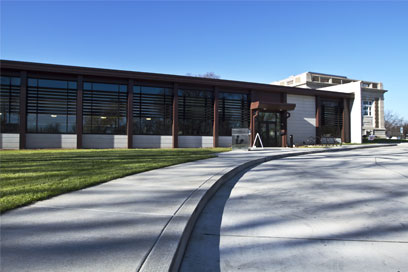Make our libraries accessible, public and inspiring

Plans to renovate the New York Public Library, unveiled today, are noteworthy for a few things. Most important, the concept by Foster + Partners opens up existing library space never visited by the library's users.
The design is deferential to its history, too, while trying hard to innovate in tight quarters.

The scheme, first reported today by Robin Pogrebin at The New York Times, reinvents the library's closed-off, seven-floor stacks as "a major new contemporary library within Carrère & Hastings’s neo-Classical one." Tall windows will open to Bryant Park in a soaring new atrium, reached by a grand circulation zone opening through the middle of the building.
The original designs notoriously offered to relocate all the stacks' books to an inaccessible warehouse in New Jersey. Yet the new plan still decimates the collection, hauling away 25% of the books that are now within the community's reach.
On the other side of the fiscal cliff, do we land with a thud in a desert of vanishing public service?
In cities and towns across the land, our libraries are losing fast. Rather than expanding and improving our centers of public information and literacy, we're seeing their budgets and hours cut back.
Libraries: Strategic or "seductive"?
The Foster and Partners scheme gets a few things right. It takes a strategic, sensible approach; it builds on existing assets for a surprisingly economical remake. This is unlike too many recently unveiled grand schemes -- the Moshe Safdie and Associates plan for a glamorous, swooping glass addition to the Philadelphia's Beaux-Arts original library leaps to mind.
In 2003, Safdie said the library should be "seductive." Calculated then at $110 million, the costly renovation and addition was rationalized because it would draw regional crowds, not just neighborhood users. The budget ballooned to $175 million, and last year was scaled back by almost half its square footage.
I remember another architect who vied for the job, maestro Cesar Pelli, who bluntly warned of budget issues in his public presentation.
It's not surprising. This kind of glamorized thinking and concentration of public good is not what libraries are about. The resulting planning and over-the-top design ideas lead us away from a library's true mission. Instead, we get nasty purplish blobs, like the one Future Systems designed in 2007 for the national library of the Czech Republic.
Or we get a "mountain of books," another strange seduction. Since MVRDV's famous mound of stacks appeared under a delicate glass and wood shell in early October -- the Spijkenisse Book Mountain, near Rotterdam's dockland -- people with limited mobility have been nonplussed. They come in and see lots of stairs, and hear tell of a 1,600-foot-long path of bookshelves. A summit cafe rewards the ablest climbers.
Yet it's an exciting notion, I suppose. Enough so that China considered its own Baiyun Mountain of Books in Guangshou. But is this meant as a draw for tourists and thrill seekers? Is it for our everyday users?
With Seattle Public Library's Central Library, Rem Koolhaas and OMA showed us how to make a library that is exciting and monumental but also efficient, economical and accessible.
Make libraries better
Still, Seattle may have been a bit too monumental to operate effectively a few recessionary years later.
Recently designed, successful libraries have a few common architectural attributes, according to the British public resource, Designing Libraries, including "more open spaces, co-located civic services" and evodence of their "external partnerships." The group also congratulates "innovative design in partnership with the community and in reference to the past."
Foster + Partners appears to hit the right notes for innovation and perhaps deference to the past.
But the future is more likely to look like the Lincoln Branch, a community library in Peoria, Ill., that opened last week. Architects at Farnsworth Group took control of a fast-shrinking budget and restored the original 1911 Carnegie building while added a modest and modern, 12,000-square-foot addition. Inside, it's comfy if a bit stark, but that's how smaller cities roll today. Inside, there's a "hot-air balloon theme" for the storytime room. Corny, yes, but here's a great library -- a lasting resource that the neighbors already love.
New York got it right in the outer boroughs, where the Queens Library renovated and expanded its classic main branch with a Children's Library Discovery Center, a beacon to the community with a playful "discovery center" interior. It is strikingly similar in concept to the Lincoln Branch, but with suitable, inner-city sophistication.
In a similar vein, the design team at Eskew+Dumez+Ripple in New Orleans took a historic 1917 bungalow built and a 1993 library to create the Rosa F. Keller Library & Community Center, in their hometown. It's modern, light, bright and embracing of the community.
A few other successes opened this year, including Salt Lake County Library's West Jordan branch, which creates a civic emblem and flexible resources for events. MHTN Architects made it a visually stunning place to be, indoors or out, at a reasonable cost.
Big libraries are for nation-building
Okay, I understand. Big cities need big, grand things. But not at the expense of communities.
The Chronicle of Higher Education organized a spoof design competition a few years ago for a new presidential library. While making light of the soon-to-be-unveiled George W. Bush facility, it inadvertently reinforced the symbolism and import associated with national libraries.
The joke was on us. In fact, it seems that national libraries are indeed the place for the grand gesture, the big-ticket dream design. The purplish blob, maybe?
One must admit the Foster and Partners New York Public Library program is good, as presented by the architects and library leadership: It will brings hundreds of computers for the public, and a children's library with a reading area and even a craft room for preschoolers.
But the idea of children and students and seniors and busy people having to commute to a massive central library? This never really works, even where parking is plentiful or where public transit is speedy and cheap.
Let's stop fixating on the bloat and seduction of the epic central library. It's out of synch with our times -- and more important, out of reach of our communities. Instead, build more local branches using the best of our existing assets, as we see in Peoria, New Orleans and Queens. Applaud these meeker municipalities and modest architects who know how to bring us local intervention -- books and computers closer to the public -- not grand destinations.
This post was originally published on Smartplanet.com